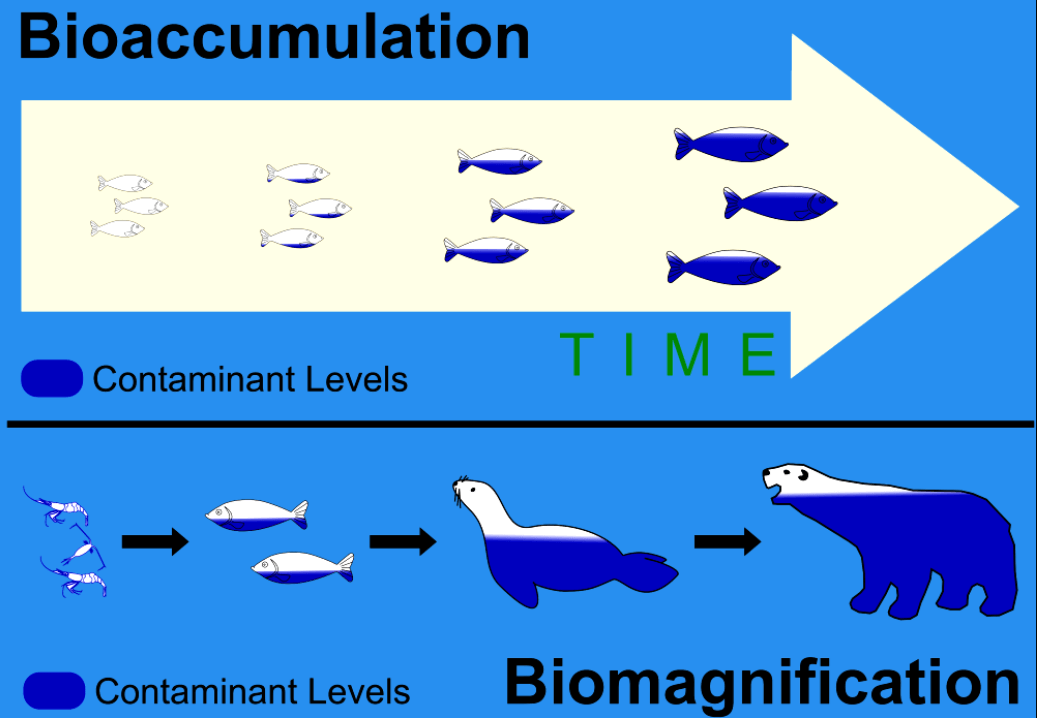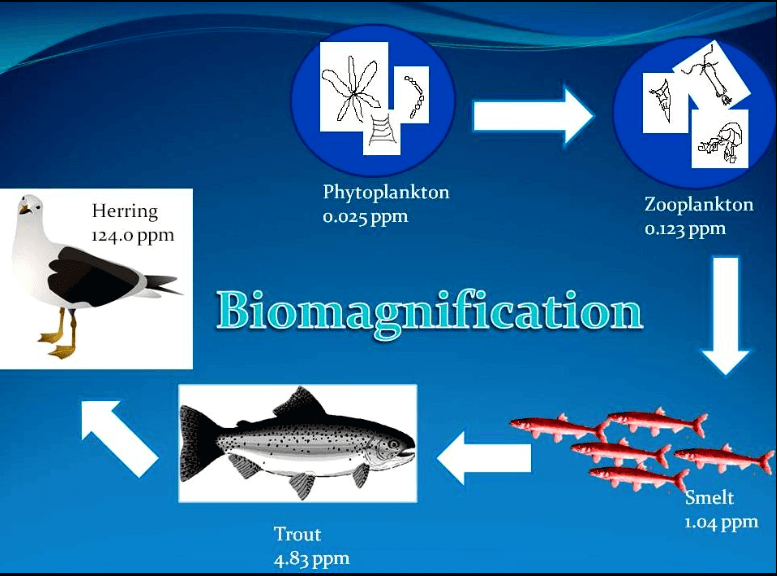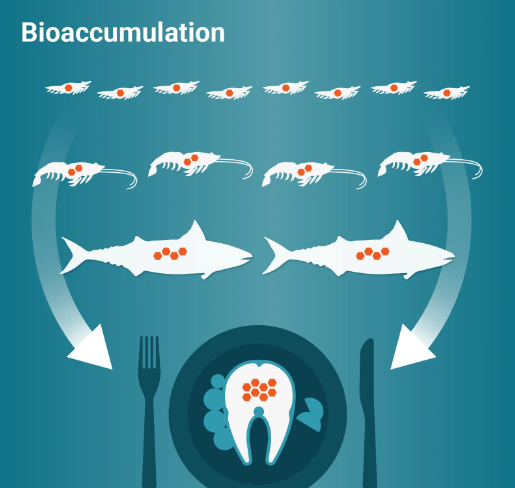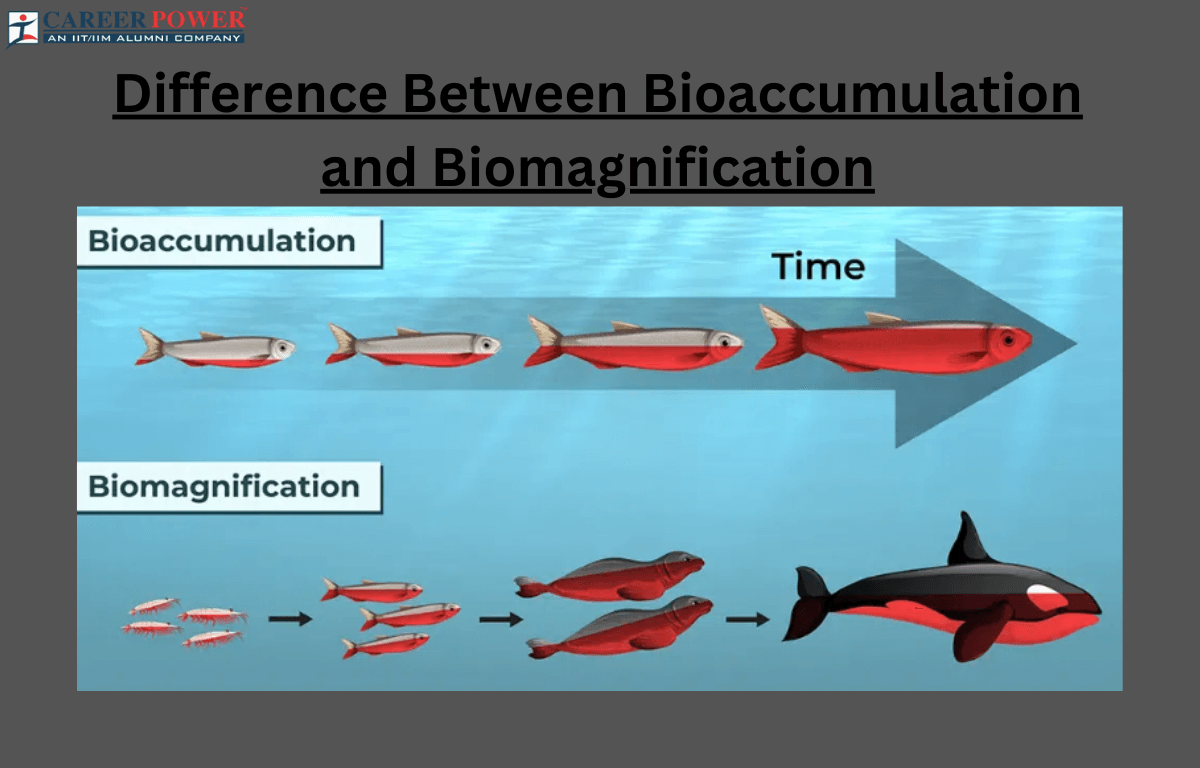Biomagnification and Bioaccumulation
Both Biomagnification and Bioaccumulation are processes in which harmful substances, like pesticides or heavy metals, build up in living organisms over time. Bioaccumulation occurs when an organism absorbs these substances from its environment faster than it can eliminate them. As organisms consume each other, the concentration of these substances increases in higher trophic levels through a food chain. This magnification of toxins up the food chain is known as biomagnification, posing potential risks to top predators, including humans, who may consume contaminated organisms.

What is Biomagnification?
Biomagnification is a process where certain substances, often pollutants, become more concentrated as they move up the Food Chain. It typically starts with small organisms absorbing these substances from their environment. As larger organisms consume those smaller ones, the concentration of the substances increases because they accumulate in tissue rather than being excreted. This phenomenon is especially concerning when it involves harmful chemicals like pesticides or heavy metals.

For example, if a small fish in a polluted water body consumes contaminants, a bigger fish eating many of those small fish will accumulate a higher concentration of the pollutants. This process continues up the food chain, potentially reaching levels harmful to top predators, including humans who consume such contaminated organisms. Biomagnification thus highlights the interconnectedness of ecosystems and the impact of human activities on environmental health.
What is Bioaccumulation?
Bioaccumulation is the gradual buildup of substances, often pollutants, in the tissues of living organisms over time. This occurs when an organism takes in these substances at a rate greater than it can eliminate them. The process typically begins with the absorption of these substances from the environment, such as through food, water, or air. Unlike biomagnification, which focuses on the increase in concentration up the food chain, bioaccumulation emphasizes the accumulation within an individual organism.

For example, if a fish is exposed to a pollutant in its habitat, it may accumulate this substance in its body tissues. Over time, if the exposure continues, the concentration of the pollutant in the fish increases. This can have detrimental effects on the health of the organism and may pose risks to other species, including humans if they consume organisms with high levels of accumulated pollutants.
Difference Between Biomagnification and Bioaccumulation
Below we have discussed a few points that will highlight the difference between Biomagnification and Bioaccumulation.
| Difference Between Biomagnification and Bioaccumulation | ||
| Features | Biomagnification | Bioaccumulation |
| Definition | Biomagnification Biomagnification increases the concentration of substances at higher tropic levels in a food chain. | Bioaccumulation is a gradual buildup of substances within the tissues of an organism over time. |
| Scale | Biomagnification involves the entire food chain, magnifying concentrations as you move up. | Bioaccumulation occurs within an individual organism. |
| Focus | Biomagnification focuses on the concentration increases as you go up the food chain. | Bioaccumulation is concerned with the accumulation of substances within an organism. |
| Level of Organization | Biomagnification Involves interactions within a food chain. | Bioaccumulation happens at the individual organism level. |
| Process | Biomagnification involves the transfer of substances through the food web. | Bioaccumulation involves the uptake and storage of substances over time. |
| Movement in Ecosystem | Biomagnification reflects the movement of substances through different tropical levels. | Bioaccumulation occurs within a specific organism’s body. |
| Impact on Organisms | Bioaccumulation can impact entire populations and ecosystems, especially higher tropic levels. | Bioaccumulation affects individual organisms. |
| Example | One of the examples of Biomagnification is the increasing levels of DDT in Birds of prey. | Examples of Bioaccumulation include the accumulation of mercury in fish tissues. |
| Timeframe | Biomagnification reflects the dynamic process in a food chain. | Bioaccumulation happens continuously over an organism’s lifetime. |
| Regualtion and Control | Biomagnification requires a broader ecosystem, level management, and regulation. | Bioaccumulation can be regulated at the individual organism level. |
Importance of Biomagnification and Bioaccumulation
Biomagnification and Bioaccumulation are crucial ecological processes with implications for both wildlife and human health. Bioaccumulation refers to the gradual buildup of substances in an organism over its lifetime, while biomagnification is the increasing concentration of a substance at higher trophic levels in a food chain. Understanding the importance of these processes is vital for sustainable environmental management and the protection of both ecosystems and human well-being.
Importance of Biomagnification
- Concentration of Toxins: Biomagnification leads to an increase in the concentration of harmful substances (such as heavy metals or pesticides) as they move up the food chain. Lower trophic levels may have lower concentrations, but these compounds accumulate and become more concentrated in the tissues of organisms at higher tropic levels.
- Impact on Top Predators: Top predators, being at the highest tropic levels, are more susceptible to biomagnification. This can have severe consequences for species at the top food chains, as they may experience adverse health effects due to the accumulation of toxins.
- Ecosystem Health: Biomagnification can serve as an indicator of ecosystem health. If toxins are present in high concentrations in top predators, it may signify Pollution issues in the environment.
- Human Health Concerns: Humans, often at the top of terrestrial food chains, can be directly impacted by biomagnification. Consuming organisms with high concentrations of toxins may lead to health issues for human populations.
- Specific Vulnerability: Certain species may be more vulnerable to biomagnification based on their feeding habits and tropic levels. Understanding these dynamics is crucial for the conservation of vulnerable species.
- Long-Term Effects: Biomagnification can have long-term effects on populations and ecosystems. Even if pollutants are present in the environment in low concentrations, their magnification through the food web can lead to significant impacts over time.
Importance of Bioaccumulation
- Ecological Impact: Bioaccumulation can lead to higher concentrations of substances in organisms at higher concentrations of substances in organisms at higher tropic levels, impacting ecosystems and potentially causing harm to species.
- Toxic Amplification: It magnifies the toxicity of certain pollutants, as organisms at higher trophic levels accumulate toxins from multiple prey items, leading to increased concentration.
- Human Health Concerns: Bioaccumulation in edible species raises concerns for human health when consuming contaminated seafood or other organisms, as humans can be exposed to elevated levels of pollutants through the food chains.
- Long-Term Effects: The persistent nature of some pollutants means that bioaccumulation can have long-term effects on species and ecosystems, even after the initial introduction of the contaminant has ceased.
- Biomonitoring: Monitoring bioaccumulation levels in certain species can serve as an indicator of environmental pollution, helping scientists and policymakers assess the health of ecosystems and make informed decisions about conservation and pollution control.
- Global Impact: Bioaccumulation is a global concern as pollutants can travel across ecosystems and impact wildlife and human populations far from the original sources, emphasizing the interconnectedness of ecosystems on a global scale.



 50 Vegetables Name for Kids in English a...
50 Vegetables Name for Kids in English a...
 Food Chain: Definition, Types, Examples,...
Food Chain: Definition, Types, Examples,...
 Human Respiratory System: Definition, Di...
Human Respiratory System: Definition, Di...













